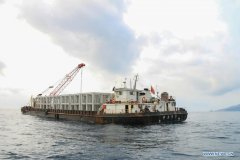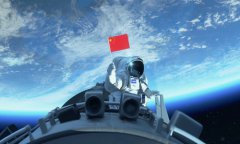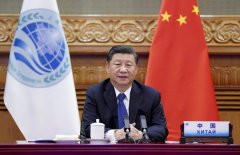China launches main part of its 1st permanent space station
China has launched the main module of its first permanent space station that will host astronauts long term
April 29, 2021, 5:30 AM
5 min read
Share to FacebookShare to TwitterEmail this articleIn this photo released by Xinhua News Agency, the core module of China's space station, Tianhe, on the the Long March-5B Y2 rocket is moved to the launching area of the Wenchang Spacecraft Launch Site in southern China's Hainan Province on April 23, 2021. China plans to launch the core module for its first permanent space station this week in the latest big step forward for the country’s space exploration program. The Tianhe, or “Heavenly Harmony” module is set to be hurtled into space aboard a Long March 5B rocket from the Wenchang Launch Center on the southern island of Hainan. The launch could come as early as Thursday night, April 29, 2021 if all goes as planned. (Guo Wenbin/Xinhua via AP)
BEIJING -- China on Thursday launched the main module of its first permanent space station that will host astronauts long term, the latest success for a program that has realized a number of its growing ambitions in recent years.
The Tianhe, or “Heavenly Harmony," module blasted into space atop a Long March 5B rocket from the Wenchang Launch Center on the southern island province of Hainan, marking another major advance for the country’s space exploration.
The launch begins the first of 11 missions necessary to complete, supply and crew the station by the end of next year.
China’s space program has also recently brought back the first new lunar samples in more than 40 years and expects to land a probe and rover on the surface of Mars later next month.
Minutes after the launch, the fairing opened to expose the Tianhe atop the core stage of the rocket, with the characters for “China Manned Space” emblazoned on its exterior. Soon after, it separated from the rocket, which will orbit for about a week before falling to Earth, and minutes after that, opened its solar arrays to provide a steady energy source.
The space program is a source of huge national pride, and Premier Li Keqiang and other top civilian and military leaders watched the launch live from the control center in Beijing. A message of congratulations from state leader and head of the ruling Communist Party Xi Jinping was also read to staff at the Wenchang Launch Center.
The launch furthers the “three-step” strategy of building up China's manned space program and marks “an important leading project for constructing a powerful country in science and technology and aerospace," Xi's message said.
The core module is the section of the station where astronauts will live for up to six months at a time. Another 10 launches will send up two more modules where crews will conduct experiments, four cargo supply shipments and four missions with crews.
At least 12 astronauts are training to fly to and live in the station, including veterans of previous flights, newcomers and women, with the first crewed mission, Shenzhou-12, expected to be launched by June.
When completed by late 2022, the T-shaped Chinese Space Station is expected to weigh about 66 tons, considerably smaller than the International Space Station, which launched its first module in 1998 and will weigh about 450 tons when completed.
Tianhe will have a docking port and will also be able to connect with a powerful Chinese space satellite. Theoretically, it could be expanded to as many as six modules. The station is designed to operate for at least 10 years.
Tianhe is about the size of the American Skylab space station of the 1970s and the former Soviet/Russian Mir, which operated for more than 14 years after launching in 1986.
The core module will provide living space for as many as six astronauts during crew changeovers, while its other two modules, Wentian, or “Quest for the Heavens,” and Mengtian, or “Dreaming of the Heavens,” will provide room for conducting scientific experiments including in medicine and the properties of the outer space environment.









